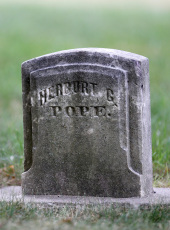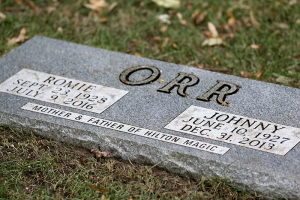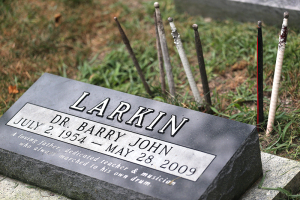A labor of love
Author: Erin Rosacker
This is an archived story. The content, links and information may have changed since the publication date.
Author: Erin Rosacker

Doug Harjes and Cheryl Robinette, groundskeepers in facilities planning and management, maintain the 2.7-acre university cemetery. Photos by Christopher Gannon.
As groundskeepers in facilities planning and management, Doug Harjes and Cheryl Robinette are tasked with maintaining ISU's on-campus cemetery. However, it may be the people within the 1.7 acres of shaded grounds who receive the most care.
Harjes and Robinette agree that their work with one of the nation's few campus cemeteries is their favorite assignment as part of the campus services staff in facilities planning and management.
"It's just so peaceful here," Harjes said.
"We really love working here," Robinette said. "We can't work out here and not be touched. It makes you realize there's more than just coming to work. Here, there is the opportunity to meet people -- either from what's written on their headstones, or from people who come to visit and tell you stories about their family member."

Herburt Pope, the son of the chemistry department chair, was the second burial in the cemetery. The first was Tom Lee Thompson, who died from pneumonia in 1875 while serving as a caretaker in the Old Main building.
Established in 1875, the Iowa State cemetery serves as the final resting place for university presidents and others with names found on campus buildings and streets. But it's the lesser-known gravesites that pique the interest of Harjes and Robinette.
"You can't help but read the headstones when you're out here and then want to find out who the people are," Robinette said.
Their work is more than keeping the grounds mowed and weeded. It also includes burials -- on average, about 15-25 each year. They work with funeral homes to coordinate services (parking is scarce on weekdays during the school year), and with families who transport remains for interment.
"Usually, when you have a funeral here, there's hardly anybody," Harjes said. "It's the opposite of what we grew up experiencing -- when you went to the cemetery, there were 150 people. Here, there's seldom more than 10 or 15."
Harjes and Robinette attribute that to the uniqueness of a college cemetery and its eligibility requirements that help manage the limited available space. Memorials and services likely are held elsewhere.
"I think a lot of times, they may have moved away after they retired," Harjes said. "Their family may live [very far away]. A lot of times they have them cremated and mail them to us."

Former Cyclone basketball coach Johnny Orr and his wife, Romie, were interred in the cemetery.
Harjes sometimes researches the names carved into headstones to find out more.
"Once in a while, especially if I know it's a military gravesite, I'll look up the obituary so I know more about the person and their service," he said. "I discovered brothers (Glen and Wayne Cunningham) who were buried next to each other and both died during World War II. I noticed the dates and ages and wrote their names down, then checked in the Gold Star Hall and they were in there."
He would like to find out if more veteran gravesites may have been overlooked.
"I thought that one day I would use the dates of World War I and look at the age of anyone that died in that era to see if they're in their 20s or 30s and narrow it down," he said.
This year for Memorial Day, Harjes and Robinette purchased large flags to denote the graves of the known war casualties buried there, including Lt. Harold Knight, who died while serving during WWII.

Each year, a visitor leaves a drumstick at the grave of former music faculty member Barry Larkin.
As Harjes and Robinette walk through the cemetery, they point to gravestones that spark their curiosity. They also share stories and anecdotes from their tenure as groundskeepers:
Both Harjes and Robinette joke (somewhat) that retirement won't stop their work at the cemetery.
"I always threaten that when I retire, I'll come back and volunteer my time here," Harjes said. "Then I can spend as much time as I want."